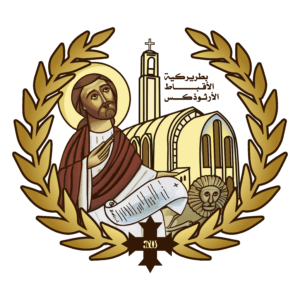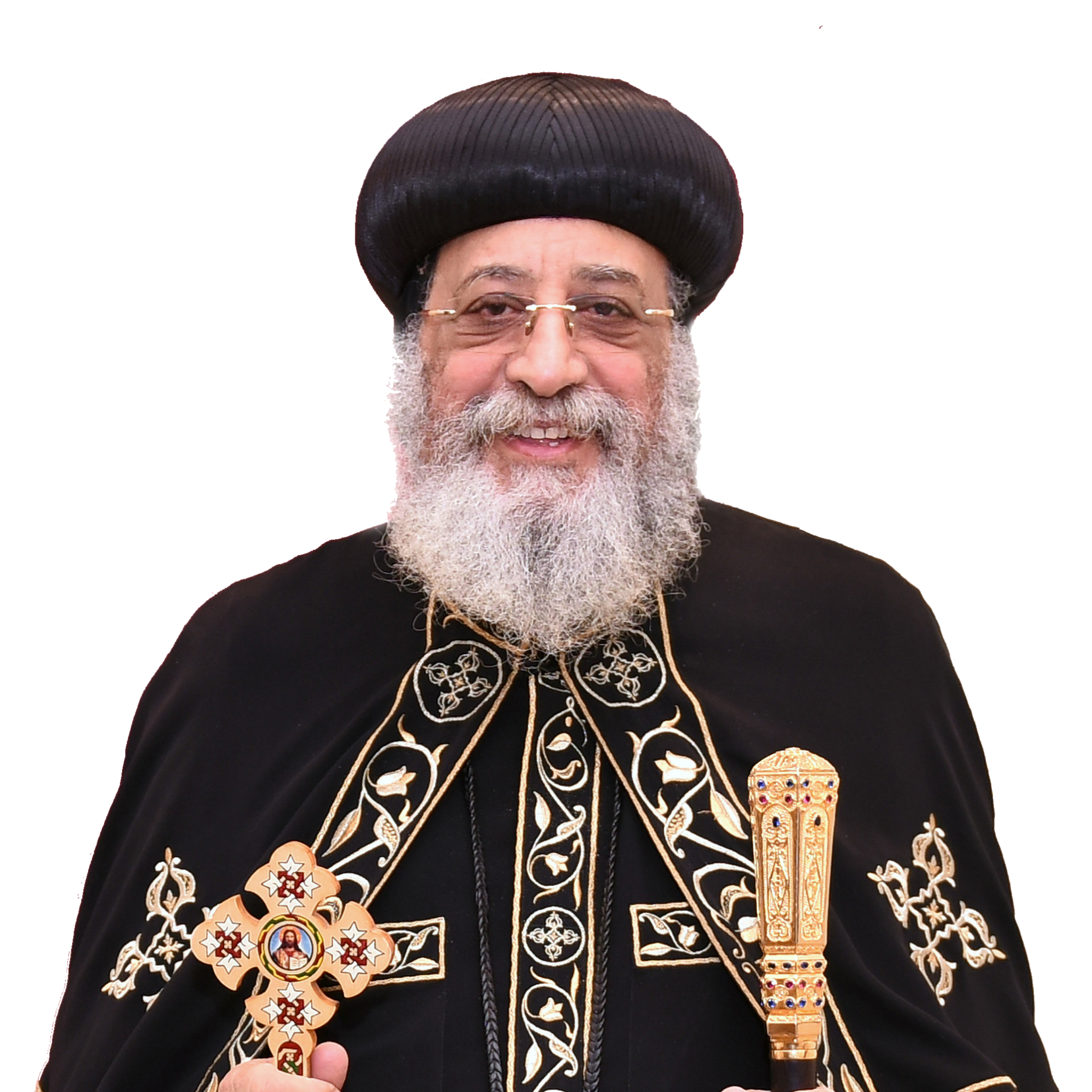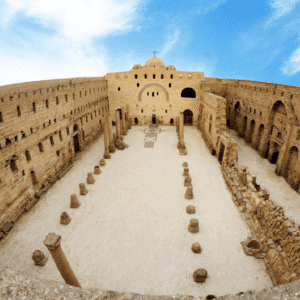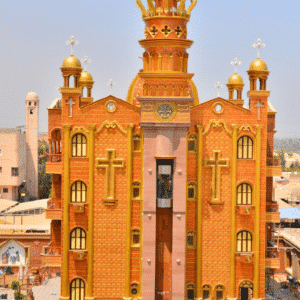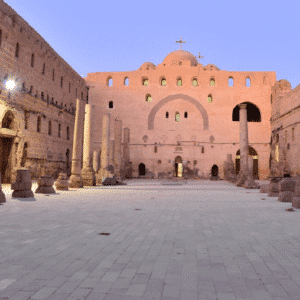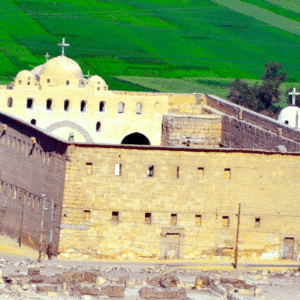St. Shenouda’s Monastery, Sohag
St. Shenouda’s Monastery, Sohag
– The Monastery of Saint Shenouda is located in the Mount of Adribah area in the western part of the city Sohag. An old, vanished one next to the monastery in the name of (Adriba), to which is attributed the Adribi melody.
– It’s called the White Monastery because it was built of white limestone, and it dates back to the second half of the fifth century 441 AD.
– It’s located at the edge of the western desert, west of Sohag about 7 km, and to the north of the city of attrib about 3 km, bounded on the east by the highway and on the west, western mountainside.
– It’s also mentioned that there was destruction in the fifth century AD, as well as an earthquake in the thirteenth century, and then the devastation that occurred as a result of the war between the French and the Mamluks, all of this led to the destruction of many of its parts have disappeared and changed its features, leaving only the monastery church, which is now surrounded in its sides north, west and south with a large amount of building rubble.
The life of Saint Shenouda the Archimandrite
– He was born in the year 347 AD and became a monk in one of the Pachomian monasteries around the year 371 AD, and when Anba Begol departed in the year 385 AD, he was appointed head of the monastery of Jabal Adraiba, known by his name, that is, the monastery of Saint Shenouda, which is the white monastery…
– Saint Shenouda established a series of monastic laws similar to the laws of St. Pachomius, but they are more strict than St. Pachomius roles, and he developed them to suit his era, and according to the new needs dictated by the spiritual position occupied by the Coptic monasticism and the main role that it began to play in the life of the Church.
– He has exchanged letters with Pope Timothy I, the 22nd Patriarch (379-385 AD) from the patriarchs of the Coptic Orthodox Church.
– His extensive knowledge of the books of the Bible is evident in the many texts he quoted from or referred to it in his sermons, letters, and articles.
– Saint Shenouda was also educated in Greek literature and fluent in the Greek language.
– St. Shenouda had a warm Coptic heart and a preoccupied mind with matters of religion and piety, Saint Shenouda’s loved Coptic literature is not only due to the greatness of his original literary production in the Coptic language, Rather, it also indicates his interest in the translation work that he adopted and supervised in his monastery.
– Despite his practice of a life of loneliness… He used to meet with the masses, individuals, and groups, and open doors of the monastery for them on Saturdays and Sundays to attend masses, hear sermons, and solve individual problems.
– There are many references in his writings to the diversity of his pastoral activities.
– The works of mercy on the authority of Saint Shenouda are very numerous. He was famous for his advocacy of the oppressed, his care for the needy, and his distribution of bread and aid to help the poor and needy, especially at the height of prices during times of famine, when the Nubian Beja tribes invaded the neighboring districts and plundered them and enslaved their people around the year 450 AD.
– Saint Shenouda sought after them and extracted from them the captives, who numbered twenty thousand men, women, and children, and hosted them behind the walls of the White Monastery, and clothed the naked among them, and fed them for three months until their homes were reconstructed.
– He appointed seven doctors to treat the wounded and treat the sick. Fifty-two children were born to them during that period, and ninety-four of them died. He shrouded them and buried them, and at the end of the period, he sent them to their countries with all the supplies they needed.
– After Saint Shenouda lived for a long time, he departed in 465 AD.
– The Arabic translation of his biography gives us a list of the number of monks at his hands in his monastery, It talks about 2,200 monks, as well as 1,800 nuns in private homes for nuns under his care.
Feast of Saint Shenouda
Coptic church celebrates the feast of the departure of St. Shenouda, the Archimandrite, on 7 the month of Abib corresponding to 14 July of each year.
Churches, buildings, and monastery headquarters
1- The Church of the Virgin Mary, the guest area.
2- The Church of Anba Shenouda and Anba Wissa, the guest area.
3- Anba Karas Church, the tourist area.
4- The Church of Anba Pachomius in Beit Al-Khilwah.
5- Anba Shenouda Church in the cave.
6- Anba Shenouda Church in Al-Qallali area.
7- Al-Qallali area.
8- The Fathers’ Families Building.
9- Accommodation building for trips.
10- The youth home building.
11- The monastery residence in Cairo, Clot Bek Street, Azbakeya area, next to the old St. Mark’s Church.
Monastery church
– It is a rectangular stone building that is mistakenly called the monastery, and it is nothing but a church in the monastery, with a rectangular hall attached to it on the southern side, As for the monastery, the monks’ residences, kitchens, ovens, stores, oil factories, and a large number of buildings whose ruins surround the monastery.
– The English archaeologist (Petry) conducted his excavations in this place in 1907 AD, where he supported the opinion that said that the present monastery church was built on this site for the second time, and that the first church was built In the time of Constantine, he relied on an archaeological study about the pottery found there.
– The current church was built on the ruins of the first church, and it is a luxurious church that shows the grandeur of Coptic architecture.
– It was also built on the ruins of Pharaonic temples of different ages.
– The Coptic architect used limestone as an essential element in the construction of this church, using a quarry in the west of the current church, called (El Kateiia).
– He also used some stones from the Temple of Atribes near this area, and this appears in the inscriptions on the stones used.
– Pink granite or gray granite was also used in the columns, lintels, and sides of the entrances.
– Red bricks were also used in the construction of some internal walls and shoulders, as well as domes, vaults, and arches.
Nave of the church
– (Fanslip) mentions that the nave of the church was covered with a gabled roof, resting on 24 columns on two rows, each row consisted of twelve columns, and the remains of the 24 columns are still present today.
– We find that the Coptic architecture has won this huge number of columns in keeping the ritual symbol, as well as the architecture of the building.
The current abbot of the monastery: Bishop Ologios
Confession of the Holy Synod to restore monastic life to the monastery of Saint Shenouda
The Holy Synod of the Orthodox Church, Monasticism & Monasteries Committee, recommended that the Holy Synod recognize the restoration of monastic life to this monastery by His Holiness Pope Shenouda III and its joining the recognized monasteries of our Coptic Orthodox Church.
